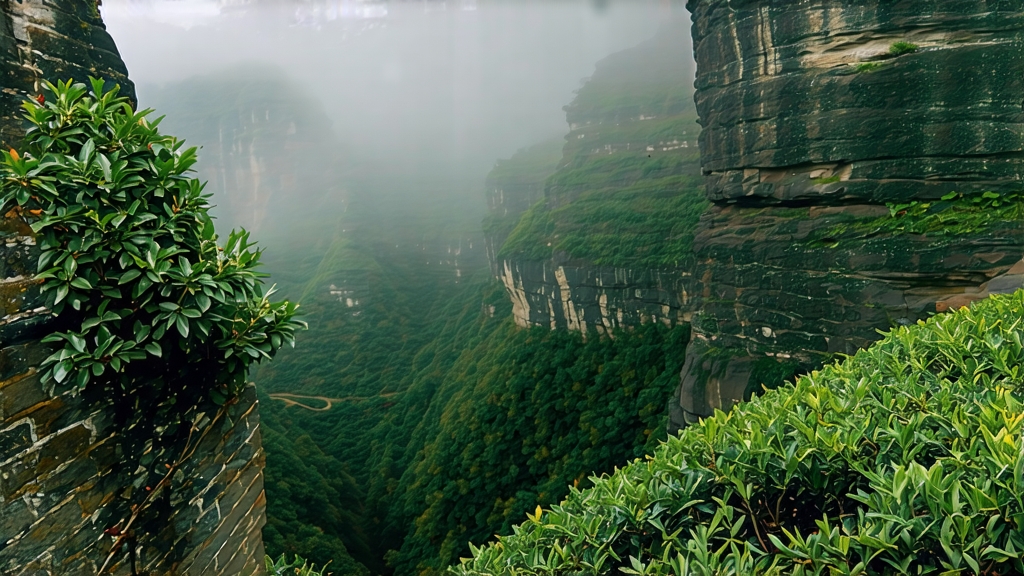
Wuyi Da Hong Pao—literally “Big Red Robe”—is the most mythic name in the oolong universe. Born on the vertiginous cliffs of northern Fujian’s Wuyi Mountains, this tea carries the scent of pine-smoke and the memory of monks who once lowered themselves on ropes to harvest leaves from bushes rooted in almost pure rock. International drinkers often meet it first through airport gift tins, yet the true Da Hong Pao remains a living, evolving craft that marries geology, fire, and time. To understand it is to taste the mineral pulse of China’s Danxia landscape and the patience of artisans who still sleep beside charcoal kilns so the temperature never wavers.
History: From Imperial Robe to Global Cup
The Song dynasty (960-1279) already records tribute tea from Wuyi, but the “red robe” legend crystallizes in the Ming. According to one version, the mother of a Ming emperor lay feverish; monks from the Nine-Dragon Cave presented a brew of cliff tea, and the court dispatched an imperial scarlet robe to drape the four mother bushes in gratitude. Another tale speaks of a scholar who cured the emperor himself, receiving the same honor. Whatever the truth, the robe became symbol, and the name stuck. By the Qing, Da Hong Pao was freighted onto mule trains northward, traded for Mongolian horses along the Tea Road. In 1985, when Wuyi’s state farm released the first commercial clonal blend replicating mother-bush genetics, the modern era began. Today, genuine mother-bush leaf is essentially unavailable; what circulates are “purebred” qi-dan cuttings or skillful blends of three to five Wuyi cultivars that recreate the classical profile.
Terroir: Why “Rock Rhyme” Matters
UNESCO lists the 60-kilometer Wuyi gorge as a World Heritage Danxia landform. Here, vertical cliffs of purple-red tuff force tea roots to drill into fissures just centimeters wide. Daytime cliff-face temperatures can reach 40 °C, while night-time mountain mist drops to 18 °C; the diurnal swing of 20 °C locks in fragrant amino acids. The gorge’s Hui-yuan pit—literally “hollow where rivers meet”—is the epicenter, but micro-gardens such as Nine-Dragon, Sky-Cart, and Three-Pit-Narrow each lend different mineral accents. Locals speak of yan yun—“rock rhyme”—a tactile finish like wet slate that lingers in the throat and reappears minutes later as a cool, sweet echo. No other oolong, not even Taiwan’s alpine Qing Xin, can replicate this lithic signature because the substrate itself is the flavor.
Cultivars: The DNA Behind the Robe
The original six mother bushes, still alive but no longer harvested, are genetically identical to the Bei Dou #1 clone preserved in the Wuyi Star Nursery. Yet “Da Hong Pao” on the market is usually a blend engineered to hit classical cupping notes: cinnamon, ripe peach, charcoal, and the tell-tale rock rhyme. Typical recipe: 40 % Qi Dan (the closest to mother-bush DNA), 30 % Rou Gui for spice, 20 % Shui Xian for orchid depth, and 10 % Mei Zhan or Huang Guan Yin for top-note honey. Each component is processed separately, then “married” after final firing, allowing the blender to balance vintage spice against fresh florals.
Craft: The Eight Stages of Cliff Oolong
- Picking: two leaves and a bud around 10 a.m. when dew has lifted but sun is still soft.
- Wilting: leaves are shaken onto water-permeable bamboo trays set on cliff ledges; mountain wind replaces indoor fans.
- Yao-qing (“rock shaking”): the unique Wuyi tumbling—200 rotations in a 1.2-meter rattan drum—bruises edges while keeping leaf center intact, initiating edge oxidation only.
- Shaqing: a 280 °C wok for 90 seconds halts oxidation at 30–40 %.
- Rolling: cloth-wrapped bundles are kneaded until leaf cells extrude a glossy sap, pre-forming the characteristic “strip-and-twist” shape.
- Initial roast: 80 °C for two hours in an electric dryer reduces moisture to 20 %.